The Overland
The Overland is an Australian passenger train service between the state capitals of Melbourne and Adelaide, a distance of 828 km (515 mi). It first ran in 1887 as the Adelaide Express, known by South Australians as the Melbourne Express.[1] It was given its current name in 1926. Now operated by private company Journey Beyond, the train undertakes two return trips a week.[2] Originally an overnight train that stopped at large intermediate stations, it now operates during the day, stopping less frequently. The Overland was converted to standard gauge in the 1990s and now operates from Melbourne over the longer standard gauge line initially heading south to the port city of Geelong, before returning to its original route in Ararat. After departing Ararat the train stops in the Victorian towns of Stawell, Horsham, Dimboola and Nhill before crossing the South Australian border. The final stretch into Adelaide, after crossing the Murray River is over the scenic Adelaide Hills. The train contains Red Premium and Red seated accommodation and a bar/lounge car, Café 828.[3]
 | |
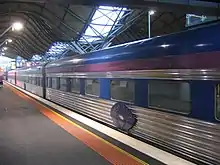 The Overland at Southern Cross station in February 2009 | |
| Overview | |
|---|---|
| Service type | Passenger train |
| Status | Operational |
| First service | 19 January 1887 |
| Current operator(s) | Journey Beyond |
| Route | |
| Start | Melbourne |
| End | Adelaide |
| Distance travelled | 828 kilometres |
| Average journey time | 10 hours 30 minutes |
| Service frequency | 2 × per week in each direction |
| Line(s) used | Western standard gauge Wolseley-Adelaide |
The Overland | ||||||||||||||||||||||||||||||||||||||||||||||||||||||||||||||||||||||||||||||||||||||
|---|---|---|---|---|---|---|---|---|---|---|---|---|---|---|---|---|---|---|---|---|---|---|---|---|---|---|---|---|---|---|---|---|---|---|---|---|---|---|---|---|---|---|---|---|---|---|---|---|---|---|---|---|---|---|---|---|---|---|---|---|---|---|---|---|---|---|---|---|---|---|---|---|---|---|---|---|---|---|---|---|---|---|---|---|---|---|
| ||||||||||||||||||||||||||||||||||||||||||||||||||||||||||||||||||||||||||||||||||||||
History


Early history
The Overland originated as the Intercolonial Express when the Victorian Railways' Western line was extended to join the South Australian Railways line at Serviceton on the state border. As both railways were 1,600 mm (5 ft 3 in) broad gauge, a through service commenced on 19 January 1887[4][5] using jointly owned rolling stock. The train was later called the Adelaide Express,[6] and ran overnight with opulent Mann Boudoir sleeping cars.[7] From 1907, new E type side corridor sitting and sleeping cars of Victorian Railways design were introduced.[8][9] More cars of these designs were added until 1923, and in 1928 two all-steel sleeping cars and a dining car were imported from Pullman Company in the United States, these being the heaviest carriages ever used in Australia.[10]
A dining car was included between Melbourne and Ararat from 1927,[11] and between Adelaide and Serviceton from 1928,[12] but with the onset of the Depression in 1930 these services were withdrawn until the mid-1930s, and finally ceased after the outbreak of World War II. The South Australian Railways purchased 500 and 600 class locomotives to haul the heavier train in South Australia. These were the largest locomotives in Australia at that time.[13] In 1936 the train was renamed The Overland, and the original deep red livery was replaced by green and yellow with black horizontal lining.[14] The SAR streamlined some of its 500 class locomotives for the makeover. In 1941 Victorian steam locomotive H220 was introduced to service, intended to haul the train but never entered regular service due to weight restrictions.[15] For over 40 years Victorian Railways used A2 class locomotives, usually in pairs.
Post-war history
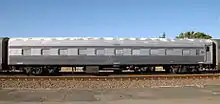
In 1946, a new style of sleeping compartment was being tested, and a mock-up of part of a carriage was built for display in Melbourne and Adelaide. The carriage portion was externally painted in green and black with yellow.[16] The sleeping cars were of two types. Twinette cars had two-berth compartments (as had the E and Mann cars before them), but each compartment had an adjoining toilet and shower room; roomette cars had single-berth compartments either side of a central aisle, and a shower room at the end of the car.[17] The maroon sleeping cars from 1949 onwards were 16 in number, later 18, and were given Aboriginal names that were painted on the sides of the cars. The eight roomette cars were Allambi, Chalaki, Juki, Mururi, Nankuri, Purpawi, Tantini, and Tarkinji; the ten twinette cars Dorai, Kuldalai, Malkari, Mokai, Nomuldi, Paiti, Tawarri, Weroni, Yankai, and Yanni. From 1949 the train moved into the modern era, with new air-conditioned Corten steel carriages gradually entering service, in maroon with a fluted stainless steel panel on each side and a black roof. This livery remained until the 1990s.
On 7 September 1951, the westbound service collided with the eastbound service at Serviceton station with four A2 class locomotives destroyed and one fatality.[18][19] Diesel locomotives took over in 1953, with the introduction of the South Australian 900 class and Victorian B class.[20][21][22] The superior acceleration of the latter allowed 70 minutes to be shaved off the journey time without exceeding the 60 mp/h limit.[23][24] These were superseded by the 930, S, X and N class locomotives.[25]
Twinette cars Tawarri and Yankai were added in 1967,[26][27] and these also followed the newer style of interior. Thus from the early 1970s onwards in the newer style there were two roomette cars, Allambi and Tantini, four twinette cars, Dorai, Tawarri, Weroni, and Yankai. In 1971, roomette cars Allambi and Tantini and twinette cars Dorai and Weroni[28][29][30][31] were sold to the Victorian Railways for use on The Vinelander to Mildura, and replaced with new carriages.[32] They were repainted dark blue and their names removed; these names were then applied to the same type of new cars built to replace them. The interiors of these new cars were of a more modern design than the older cars. The roomette cars had a zigzag corridor instead of a straight one, and the compartments had the shape of a trapezium. This enabled the use of the toilet and washbasin units while the bed was still down, not possible in the older roomettes.
In 1975, Australian National took over the South Australian Railways and became joint operator of the train with the Victorian Railways.[33] From 18 May 1984, the Adelaide terminus was changed from Adelaide station to Keswick Terminal in Adelaide's Park Lands.[5] A snapshot of the service in November 1990 included a car carrier (AMBP), two sleepers, a club car, another two sleepers, a first, second/buffet and second sitting cars and a luggage van, hauled by two N class locomotives. In holiday seasons the train was regularly built up to 16 carriages.[34] From 1994, the train was operated solely by Australian National.[35] At this time the Melbourne to Adelaide line was converted to standard gauge, and a new route via Maroona and Geelong introduced.[35] The final broad-gauge services ran on 1 March 1995.[36] Australian National began operating their CLP class locomotives.[37]
Motorail service
A motorail service was added to the train from November 1979.[38] The service was withdrawn in the early 2000s when the vehicle loading ramp at the Melbourne end was removed as part of the Southern Cross station redevelopment,[39] It was restored in February 2009,[40] but was withdrawn again in November 2015.[41]
After privatisation
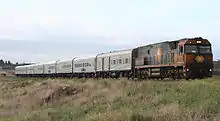
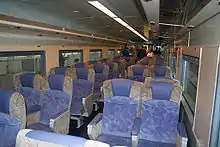
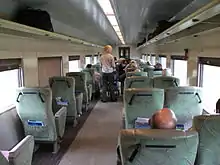
In November 1997, Australian National was sold and the passenger cars passed to Great Southern Rail Limited, which contracted National Rail to haul the services with NR class locomotives.[35][42] On occasions, BL and 93 class locomotives hauled the service.[43][44] In July 1998, the Wednesday and Saturday night journeys in each direction were cancelled, leaving the service operating five times per week in each direction.[45] In May 1999, a new timetable was introduced but with previous intermediate stops omitted at Stawell, Murtoa, Nhill, Kaniva, Wolseley, Tintinara, Coonalpyn and Tailem Bend.[46] In 1999, the maroon and silver livery was removed and the train was repainted in a new grey and silver scheme, with a new kookaburra logo.[33] In May 2000, the service was reduced to four times weekly. However, with an accelerated journey time of 10 hours 30 minutes, the service was able to be operated by one set of passenger cars, operating to Melbourne in the day and to Adelaide overnight.[47][48]
In May 2007, Great Southern Rail re-timetabled the service to operate three times weekly in daylight after the passenger cars had been overhauled with a new blue, purple and green livery applied and interiors renewed.[49][50] A new running emu logo was also introduced.[2] From August 2008, 12 seats per train were made available to passengers within Victoria at V/Line fares.[51] In October 2010, it was announced that the train would stop at Stawell. At the same time, the number of seats available on V/Line fares was increased to 64 per train.[52] In August 2013, the three-times weekly service was reduced to twice-weekly.[53][54]
Uncertainty
From 2007, The Overland continued to operate with a $1.5 million annual subsidy from the Victorian State Government.[55] In August 2015, concerns were raised about the future of the service when GSR announced that, because the Federal Government's subsidy of the fares of pensioners, veterans and seniors taking train journeys would end in July 2016, services on GSR's other trains, The Ghan and the Indian Pacific, were to be halved.[56] Later in the month, the South Australian Government announced that it would support the service as part of a $1 million deal with the company.[57]
In 2017, Great Southern Rail Limited re-branded its operations as "Journey Beyond".[note 1]
In 2018, 20 years of subsidies from the two state governments appeared likely to cease: although the Victorian Government renewed its subsidy for 15 months in August, the South Australian Government announced in November that it had decided not to renew its subsidy beyond the end of the year.[59] In December, however, the Victorian Government announced it would fund the shortfall to allow the service to continue in 2019.[60][61] The service was again threatened with withdrawal in December 2019 before a last-minute agreement for the Victorian government subsidy to continue until March 2020 was reached.[62] In that month, the COVID-19 pandemic necessitated all "Journey Beyond" train services to be suspended. In June 2020, the Victorian Government committed to a three-year funding agreement to support The Overland, providing $3.8 million per year until June 2023; services were tentatively scheduled to start again in September 2020.[63][64]
Note
- "Journey Beyond" is a business name of Experience Australia Group Pty Ltd ABN 56 614 713 003[58]
References
- Turner, Jim (2014). Australian Steam Locomotives 1855–1895. BookBaby. ISBN 9780992432683. Retrieved 7 December 2017.
- The Overland Archived 23 October 2011 at the Wayback Machine Great Southern Rail
- "TrainReview's guide to The Overland".
- An Introduction to the Overland Story Rowland, E.C. Australian Railway Historical Society Bulletin January 1977 pp1-16
- Callaghan, WH (1992). The Overland Railway. Sydney: Australian Railway Historical Society. pp. 48, 213. ISBN 0 909650 29 2.
- ARHS Railway Museum: Railway History in Victoria 1839 – 1900 Archived 29 September 2009 at the Wayback Machine
- David Burke (1978). Great Steam Trains of Australia. Rigby. p. 78.
- "AE Sitting Carriages – V&SAR Joint Stock". Chris' Commonwealth Railways Pages.
- ""Loddon" – Sleeping Car No. 10 – V&SAR Joint Stock". Chris' Commonwealth Railways Pages.
- ""Mount Lofty" – Pullman Sleeping Car". Chris' Commonwealth Railways Pages.
- "Hopkins". Chris' Commonwealth Railways Pages.
- ""Adelaide" – Pullman Dining Car". Chris' Commonwealth Railways Pages.
- Burke. Ibid. p82.
- Comrails: V&SAR Joint Stock – Wooden Vestibule
- ARHS Railway Museum: Railway History in Victoria 1900–1950 Archived 27 September 2007 at the Wayback Machine
- Newsrail February 1997 p.57-58, letter by David Parsons.
- Commonwealth Railways had showers in some sleeping cars from 1919
- Rail Disaster at Serviceton Barrier Miner 7 September 1951
- Expresses Collide at Serviceton: One Dead, Passengers Shaken Canberra Times 8 September 1951
- "Diesel-Electric Operation in South Australia" Railway Gazette 25 September 1953 page 338
- SteamRanger: SteamRanger's Diesel Locos and Railcars
- Victorian Railways: B class diesel electric locomotives Archived 4 December 2007 at the Wayback Machine
- "Record Breaking by Victorian Railways Diesels" Railway Gazette 4 September 1953 pages 253/254
- "The Overland Limited" Locomotive, Railway Carriage & Wagon Review issue 736 December 1953 page 198
- National Railway Museum – Port Adelaide: 930-class
- Tawarri – V&SAR Joint Stock Steel Sleeping Car Chris' Commonwealth Railways Pages
- Yankai – V&SAR Joint Stock Steel Sleeping Car Chris' Commonwealth Railways Pages
- Allambi Chris' Commonwealth Railways Pages
- Tantini Chris' Commonwealth Railways Pages
- Dorai Chris' Commonwealth Railways Pages
- Weroni Chris' Commonwealth Railways Pages
- Comrails: Steel V&SAR Joint Stock Carriages Chris' Commonwealth Railways Pages
- The Overland Chris' Commonwealth Railways Pages
- Newsrail November 1990 page 332
- Railway History 1950 – 1975 ARHS Railway Museum
- "Newsline Interstate" Railway Digest April 1995 page 16
- "Morrison Knudsen Australia and the CLPs" Railway Digest June 1994 Page 16
- Vincent Adams Winter (1990). VR and VicRail: 1962 – 1983. p. 206. ISBN 0-9592069-3-0.
- The Overland Motorail Great Southern Rail
- "Passengers Can Now take Their Car by Train to Adelaide". Media Release: Minister for Public Transport. 18 February 2009.
- "Motorail". Archived from the original on 9 October 2015. Retrieved 13 April 2018.
- "Goodbye AN Passenger, Hello Great Southern Railway" Railway Digest December 1997 page 7
- "SA Standard Gauge" Railway Digest" May 1999 page 37
- The Overland Newsrail June 2014 page 181
- "GSR Announce Changes to Ghan & Overland" Railway Digest August 1998 page 10
- "Geelong Standard Gauge Platform Opens, Overland Accelerated but Stations Bypassed" Railway Digest July 1999 page 17
- "Passenger in Brief" Railway Gazette International May 2000 page 288
- "SA Short Lines" Railway Digest October 2000 page 10
- "Overland upgrade announced" Railway Gazette International April 2006 page 192
- Refurbished Overland Train Ready to Roll Minister For Public Transport 8 May 2007
- New Train Services for Western Victoria Premier of Victoria 25 August 2008
- "All Aboard: Train Services Return to Stawell – Premier of Victoria". Minister for Public Transport. www.premier.vic.gov.au. 14 October 2010.
- Change of Schedule – The Overland Great Southern Rail
- "Overland's last Thursday departure" Railway Digest October 2013 page 22
- Overland bypasses Stawell station Stawell Times 23 January 2007
- "Great Southern Rail to halve services on Indian Pacific, The Ghan after Federal Government cuts". ABC News. Australian Broadcasting Corporation. 6 August 2015. Retrieved 28 August 2015.
- MacLennan, Leah (27 August 2015). "Overland train deal with South Australian Government secures more jobs for Adelaide". ABC News. Australian Broadcasting Corporation. Retrieved 28 August 2015.
- "Current details for ABN 56 614 713 003". ABN Lookup. Australian Business Register. 2020. Retrieved 14 August 2020.
- Boisvert, Eugene (29 November 2018). "Overland Adelaide-Melbourne train service set to be cancelled after SA funding axed". ABC News. Australian Broadcasting Corporation. Retrieved 29 November 2018.
- "Stepping In To Save The Overland For Western Victoria". Premier of Victoria. 11 December 2018. Retrieved 11 December 2018.
- Victoria to fund the Overland in 2019 Railway Gazette International 11 December 2018
- Overland train service to continue until March 31 Murray Valley Standard 6 January 2020
- Wales, Sean (30 June 2020). "The Overland train between Melbourne and Adelaide is given a three-year lifeline by Victorian Government". ABC News. Australian Broadcasting Corporation. Retrieved 1 July 2020.
- "The Overland train set to resume when borders open". InDaily. Solstice Media. 30 June 2020. Retrieved 1 July 2020.
External links
![]() Media related to The Overland at Wikimedia Commons
Media related to The Overland at Wikimedia Commons